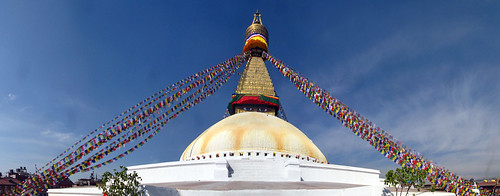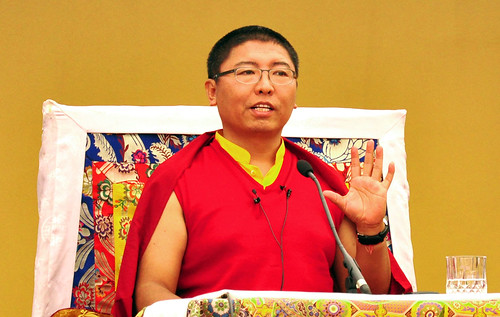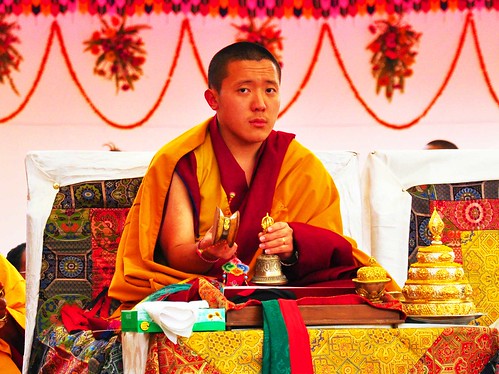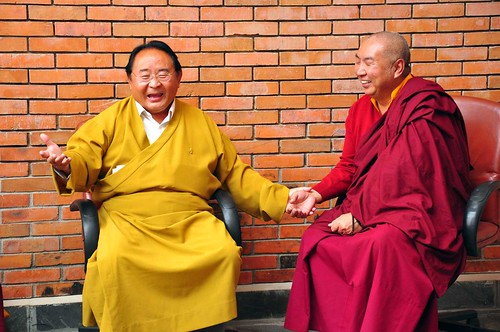After having spent a month in Hamburg relaxing and recovering from my accident in Nepal (see last post), I felt healed and strong enough to enter an airplane once again, and begin my journey to South India. Except for a trip to Sikkim three years ago and a few days in Delhi this June, I haven't spent much time in India before. It has now been 3 weeks since I arrived in Bangalore and reached
Namdroling Monastery near Bylakuppe in the Karnataka state some hours later by bus. The bus I was on appeared to be western by standard, the drivers were wearing white uniforms and the TV showed the latest piece of Bollywood entertainment. Nevertheless I had to deal with many frightening situations during the ride. These buses are likely the fastest vehicles on the highway. But just like in Nepal, the streets are shared with cows, people riding bicycles and crossing pedestrians. With all these factors the drivers have plenty of encounters where they have to manoeuvre for position. My body got tense frequently. I was relieved when we finally arrived at our destination, Kushal Nagar.
What is happening in Namdroling? The monastery of Namdroling, founded by the late
Kyabjé Penor Rinpoche, is the biggest Nyingma monastery outside of Tibet. It is home to thousands of studying and practising monks. Close by is the 'Ani Gompa', the section of the monastery where the nuns live. Also at Namdroling is the famous
Ngagyur Nyingma Insitute, the Shedra of Namdroling, which was established by
Khenpo Namdrol, the host of the
Rigpa Shedra in Pharping, and Khenpo Tsöndrü.
The Zangdok Palri temple
The Shedra East in Nepal took place for the 5th time this year. Now a few Shedra students, including myself, are participating in Rigpa's first Tibetan Translator Training here in Namdroling. For 5 months, this year, students have the opportunity to immerse themselves in the Tibetan language. Even though this is India, there is a growing number of Tibetan settlements around Namdroling as well as near the great Gelug monastery of
Sera Jé which is only 10 minutes away. This means that in addition to the monks and nuns there are many Tibetans to speak with. And this is our mission, learning to speak and understand Tibetan.
One of my first translation attempts. Can you see the smoke?
The programme offers classes of reading comprehension, a translators' training class where we are learning to translate a lobpön (a monk who graduated from the Shedra and who needs another 3 years of teaching experience before becoming a
Khenpo), and a teaching class where a lobpön guides us through a philosophical text which is translated into English. The following day we re-listen to the recording of the teaching from the previous day at a slower pace along with explanations by our instructor.
Around Namdroling
Monks recite the Kangyur in the community hall of camp #4
The Tibetan language is quite different than western languages. It can take a good amount of time for the brain to sort out the words and to put them in an order that we are used to. This process makes for an experience often accompanied by alternating joy and frustration. But I guess this is not uncommon in learning any language.
Not far away from Namdroling is the little town of Kushal Nagar reachable by a motor riksha. We occasionally go there on the weekends to buy things we need which are not available in the shops around Namdroling. Besides that the place here is pretty shanti. There is not much to do and so we can concentrate on learning and speaking Tibetan. Another factor which is conducive to delight body and mind are the cheap mangos, coconuts and pineapples that are sold at some stands. Delicious! The nature is lush here and in addition to the many fields around the Tibetan camps palm trees can be seen everywhere. It's monsoon season now which means that there is hardly a day that passes without rain. At least these days there is not too much of it, but still you better not forget your umbrella at home!
No hustle and bustle, shanti shanti.
It's not that people here haven't seen westerners before, but as a special permit is required to stay in this area, which can take months to obtain, the monks, nuns and local Tibetans are not used to having injies, the Tibetan word for westerners, around. Eventually the idea is that the students who study here will live together with families in order to be exposed to Tibetan as much as possible and also to experience first-hand the Tibetan culture versus reading about it in a book. For most of us this is not yet the case and it will require more patience and maybe effort to make this ideal situation happen.
One thing that shouldn't be forgotten is that the world cup is also happening. In case you thought that monks don't know how to have a good time, you are wrong. Occasionally I go to the monastery compound and watch the games with a bunch of monks. Sometimes I come a bit too late and when I walk through the main gate and cross the courtyard, I can hear the screams of monks coming out of the windows when a goal was shot or missed. Being a German some of them seem to be particularly excited to talk to me!
Recently, to celebrate the Local deities' day,
dzamling chisang, the Tibetans from our settlement invited us to join them in buses, drive to a hill in the vicinity and offer thousands of little paper prayer flags. In the afternoon we had a picnic with them at the foot of the hill. The excursion allowed us closer contact with them so we could apply the Tibetan language skills we've learned so far. It was a really nice experience and I think the Tibetans enjoyed having us around too. It was only after that I learned about the apparent significance of that hill. At the bottom there is a cave which many of us climbed into at one location and exited from another spot. There seem to be different opinions about who dwelt there. Some associate the cave with the great Indian Buddhist master
Nagarjuna, others say it was the
Mahasiddha Padampa Sangye who spent time in it. My tutor, a lobpön, who currently teaches the '
Introduction to the Middle Way', Uma la Jukpa, at the Namdroling Shedra, the same text we were studying in Pharping last winter, showed me a passage in the book with a quote from the
Lankavatara Sutra which predicts Nagarjuna's appearance in the South of India and mentions the name of that hill!
Above the clouds
Ki ki so so lha gyal lo!
Find more photos
here.
So, I guess it's time for me to go out, have a fresh mango juice and find a victim for my broken Tibetan!
Ps. Double-click the photos for a larger version. More are soon to appear on my flickr-site.












































